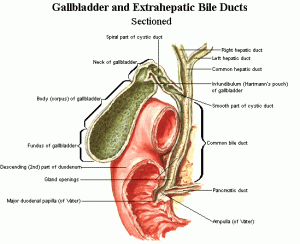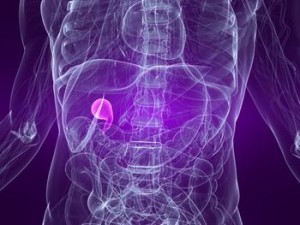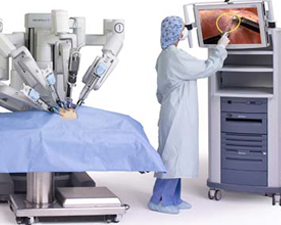Gallbladd
The wall of the gallbladder has 3 main layers of tissue.
- Mucosal (innermost) layer.
- Muscularis (middle, muscle) layer.
- Serosal (outer) layer.
Between these layers is supporting connective tissue. Primary gallbladder cancer starts in the innermost layer and spreads through the outer layers as it grows.
Gallbladder cancer is cancer that begins in the gallbladder. Your gallbladder is a small, pear-shaped organ on the right side of your abdomen, just beneath your liver. The gallbladder stores bile, a digestive fluid produced by your liver. Gallbladder cancer is uncommon. When gallbladder cancer is discovered at its earliest stages, the chance for a cure is very good. But most gallbladder cancers are discovered at a late stage, when the prognosis is often very poor.
Gallbladder cancer 
It’s not clear what causes gallbladder cancer. Doctors know that gallbladder cancer forms when healthy gallbladder cells develop changes (mutations) in their DNA. These mutations cause cells to grow out of control and to continue living when other cells would normally die. The accumulating cells form a tumor that can grow beyond the gallbladder and spread to other areas of the body. Most gallbladder cancer begins in the glandular cells that line the inner surface of the gallbladder. Gallbladder cancer that begins in this type of cell is called adenocarcinoma. This term refers to the way the cancer cells appear when examined under a microscope.
Types of Gallbladder Cancer Treatment in India

- Surgical Biliary Bypass : If the tumor is blocking the bile duct and bile is building up in the liver, a biliary bypass may be done. During this operation, the gallbladder or bile duct will be cut and sewn to the small intestine to create a new pathway around the blocked area.
- Endoscopic Stent Placement : If the tumor is blocking the bile duct, nonsurgical techniques can be used to put in a stent (a thin, flexible tube) to drain bile that has built up in the area. The stent may be placed through a catheter that drains to the outside of the body or the stent may go through the blocked area and drain the bile into the small intestine.
- Percutaneous Transhepatic Biliary Drainage : A Procedure done to drain bile when there is a blockage and endoscopic stent placement is not possible. An X-ray of the liver and bile ducts is done to locate the blockage. Images made by ultrasound are used to guide placement of a stent, which is left in the liver to drain bile into the small intestine or a collection bag outside the body. This procedure may be done to relieve jaundice before surgery.
World’s Most Advanced Robotic Surgery for Gallbladder Cancer
Single-Site da Vinci Surgery is minimally invasive – performed through a single small incision usi
da Vinci Surgery offers patients the following potential benefits:
- Minimal Scarring.
- Minimal Pain.
- Low Blood Loss.
- Fast Recovery
- High Patient Satisfaction.
To know more about “Gallbladder cancer Treatment” in India please visit this page

 Click to WhatsApp
Click to WhatsApp +91-9899993637
+91-9899993637



